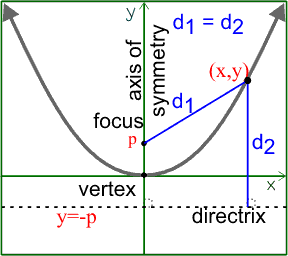How do the graphs of sine and cosine relate each of the others?
a) Tangent?
First of all, we know that sine (red) starts and ends at zero and cosine starts and ends at 1; both of their periods is 2π. Looking at the picture above, in the first quadrant, sine and cosine are both positive. Since tangent is equal to sine/cosine, you're dividing by two positive numbers so that means tangent must be positive as well. Therefore, tangent (orange) is positive in the picture. In the second quadrant, sine is positive and cosine is negative, so tangent must be negative. In the third quadrant, both sine and cosine are negative, so tangent is positive, In the fourth quadrant, sine is negative and cosine is positive; therefore, tangent is negative.
Further more, asymptotes are significant in understanding how sine/cosine correlate with tangent. From previous units, we know that tan=sin/cos and in order to have an asymptote, it must be undefined. In this case, cosine must be undefined or equal to zero. From the unit circle, x is zero at 90º (π/2) and 270º (3π/2). Those will be where the asymptotes will be. It's where tangent cannot cross or touch, as you can tell in the picture. Remember there are MANY asymptotes, it goes on forever but the picture above is just a screenshot.
b) Cotangent?
Cotangent is very similar to tangent because it's equal to cosine/sine. From the picture above, we see that cotangent (blue) is positive in the first and third quadrant because we are either dividing by a positive and positive or a negative and negative. In two and four, cotangent is negative because you're dividing by positive and negative.
For cotangent to have an asymptote, sine must be equal to zero. Looking at your unit circle, you see that y is equal to zero at 180º (π) and 360º (2π). This will be where the asymptotes will be on the graph.
c) Secant?
Secant looks very different from tangent and cotangent but it's a similar concept, just a different identity. Secant is equal to 1/cos. Now, for secant, you are just looking at the cosine line (green). Cosine is positive in the first quadrant and is being divided by one, which is positive, secant will be positive. In the second quadrant, cosine is negative; positive divided by negative is negative. Secant is also negative int bird quadrant because you're dividing by a positive and negative. In the fourth quadrant, secant is positive because it's a positive divided by a positive. Looking at the picture above, you can see that a secant graph resembles positive and negative parabolas.
Secant is equal to 1/cos, so cosine must be undefined. As stated in tangent, cosine is equal to zero at 90º (π/2) and 270º (3π/2). That will be where the asymptotes will be placed.
d) Cosecant?
The identity for cosecant is 1/sine. Therefore, we are just looking at the sine line (red) for now. In the first and second quadrant, cosecant is positive because sine is positive. In the third and fourth quadrant, cosecant is negative because sine is negative. It will look like two parabolas but there are an infinite number because the graph goes on forever.
Since cosecant is 1/sine, sine must equal zero for it to have an asymptote. This is similar to cotangent because sine is equal to zero at 180º (π) and 360º (2π). This is where cosecant must not touch or pass.
Work Cited:
https://www.desmos.com/calculator/hjts26gwst





































